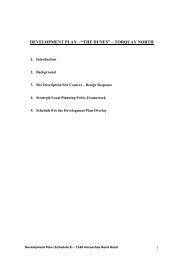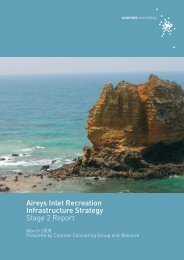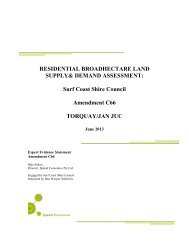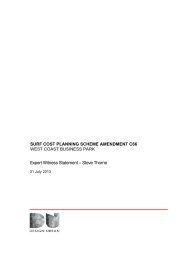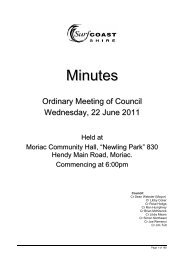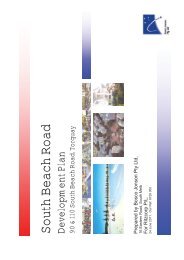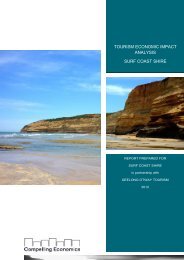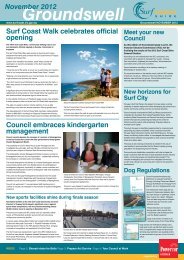Rural Strategy - Surf Coast Shire
Rural Strategy - Surf Coast Shire
Rural Strategy - Surf Coast Shire
Create successful ePaper yourself
Turn your PDF publications into a flip-book with our unique Google optimized e-Paper software.
<strong>Surf</strong> <strong>Coast</strong> <strong>Shire</strong> <strong>Rural</strong> <strong>Strategy</strong> Review<br />
Final Report<br />
(Pseudophryne semimarmorata), New Holland Mouse (Pseudomys novaehollandiae) and<br />
White footed Dunnart (Sminthopsis leucopus). Flora include a wide variety of orchids and<br />
herbs including Anglesea Grevillea (Grevillea infecunda), Southern Plume-orchid (Pterostylis<br />
tasmanica) and Bluebeard Wax-lip Hybrid Orchid (X Glossadenia tutelata).<br />
Point Addis <strong>Coast</strong>al Reserve and the Ironbark basin are included in the Great Otway<br />
National Park and link the forest park to the Marine Park. The coastal reserve supports<br />
heath, Red Iron Bark forest and coastal woodlands supporting threatened species including<br />
Bellarine Yellow Gum, Rufous Bristlebird, Brown Toadlet (Pseudophryne bibronii) and<br />
Elegant Parrot (Neophema elegans)<br />
Bells Beach and Jan Juc support Bellarine Yellow Gum in very high densities, scattered<br />
Moonah and a variety of other threatened species. The vegetation and landscape of Bells<br />
Beach is regarded as environmentally, aesthetically and culturally significant.<br />
Key attributes: Great Otway National Park covering much of the Otways and Ironbark Basin.<br />
Large areas of remnant vegetation that connect to public land supporting numerous<br />
threatened species. High quality and diverse species including trees with hollows.<br />
Key threats: Weed invasion, feral animals, urban / tourism development and subdivision<br />
and altered fire regimes.<br />
10.7.2 Future Land Use Outcomes<br />
The natural beauty of the Great Ocean Road and its settlements and hinterland makes it a<br />
popular tourist destination which brings with it development pressure for both rural living and<br />
tourist and holiday accommodation and facilities. Development between coastal settlements<br />
is strongly discouraged at the State and Local levels of government, as espoused in the<br />
Victorian <strong>Coast</strong>al <strong>Strategy</strong>, Great Ocean Road Region <strong>Strategy</strong>, <strong>Coast</strong>al Spaces <strong>Strategy</strong><br />
and <strong>Surf</strong> <strong>Coast</strong> Planning Scheme. This has been reinforced through the recent<br />
strengthening of coastal settlement boundaries and modification to the rural zones.<br />
The settlements of Anglesea to Eastern View are coastal treasures within a unique<br />
environment that is to be protected at all costs. The fragile heathlands and open dry<br />
woodlands separating these towns have a very low capability for absorbing even small scale<br />
tourist development, beyond bed and breakfast type uses. The landscape value and cultural<br />
heritage experience of the iconic Bells Beach <strong>Surf</strong>ing Recreation Reserve similarly deserves<br />
to ensure that there are no development impacts on this area of the coast.<br />
Lorne, in contrast, is identified as a tourist node and, within the constraints presented by the<br />
proximity of the National Park, the wildfire risk and specific physical site limitations<br />
(vegetation and slope), offers limited potential for low scale tourist accommodation inland<br />
from the town.<br />
The environmental significance and international landscape values of the precinct must take<br />
precedence over any form of development.<br />
RMCG Consultants for Business, Communities & Environment Page 83




